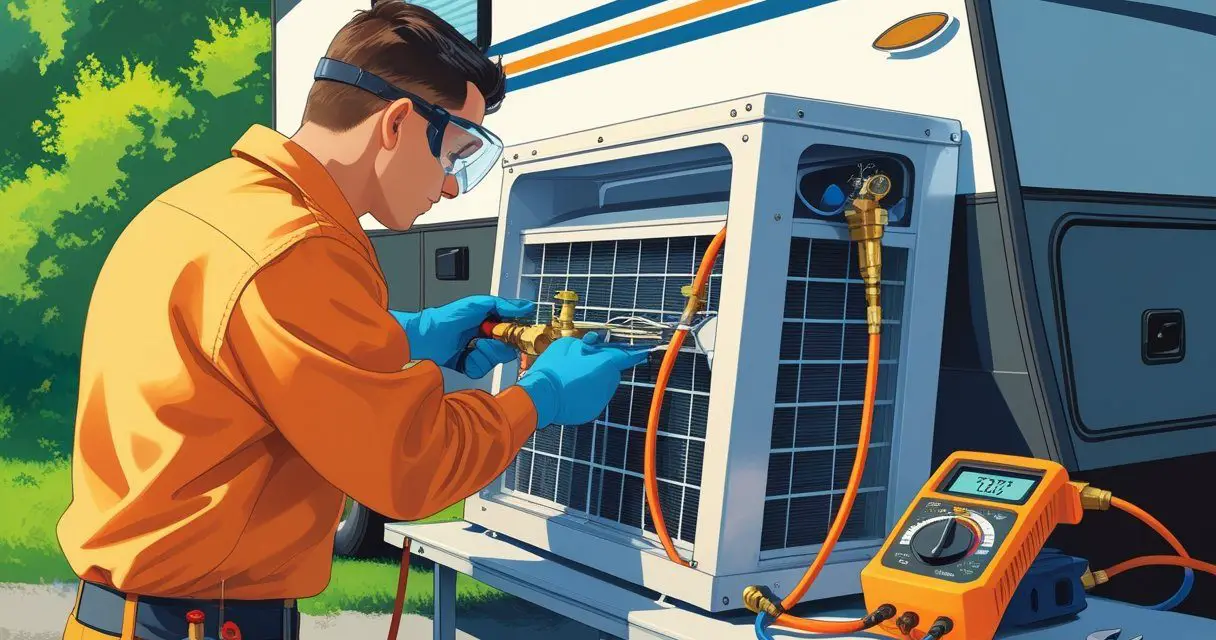Would you like to save this article?
When the air in your RV starts feeling warm and stuffy, you might wonder if the air conditioner can be recharged like a car’s AC. The short answer is that most RV air conditioners are sealed systems and usually cannot be recharged unless a leak is found and repaired by a professional.
Some older or specialized units may allow it, but for most, a recharge isn’t a simple DIY fix.
That doesn’t mean you’re out of options. Understanding how your RV’s AC works and knowing the signs of common issues can help you figure out whether the problem is refrigerant loss, airflow restrictions, or something else entirely.
By learning what really causes cooling problems, you can save time, money, and avoid unnecessary repairs.
If you want to keep your RV cool and comfortable, it’s important to know when a recharge is possible, when maintenance is enough, and when replacement might be the smarter choice.
Key Takeaways
- Most RV AC units can’t be recharged unless a leak is repaired.
- Cooling issues often come from airflow or maintenance problems.
- Regular care extends the life of your RV AC and prevents costly fixes.
Can RV AC Units Be Recharged?
Whether you can recharge an RV air conditioner depends on the type of unit you have, the refrigerant it uses, and whether the system is designed to be opened for service.
Safety, cost, and long-term performance also play important roles in deciding how to approach a recharge.
Factory-Sealed Versus Rechargeable Units
Most modern RV rooftop air conditioners are factory-sealed systems. These units are built so the refrigerant circuit cannot be opened under normal conditions.
They are designed to last without needing a recharge, and if refrigerant leaks, it usually signals a larger problem that may require replacement instead of repair.
Older RV air conditioners, however, often came with service ports that allow refrigerant recharging. These models may use refrigerants like R-22 or R-134a, while newer ones commonly use R-410a.
R-22 has been phased out, making it difficult and expensive to source, while R-410a and R-134a remain available.
If your RV AC is sealed, recharging is not a standard maintenance step. In that case, you would likely need a technician to install a port or replace the unit if refrigerant loss occurs.
Legal and Safety Considerations
Refrigerants are regulated substances, and handling them requires care. In many regions, only certified technicians can legally purchase and add refrigerants such as R-410a or R-134a.
This protects both the environment and your health, since refrigerants can cause injury if mishandled.
Leaks in an RV air conditioner should be repaired before any recharge. Simply adding refrigerant without fixing the leak wastes money and can damage the compressor.
A proper RV air conditioner repair often includes leak detection, sealing, and testing before refrigerant is added.
You should also consider environmental rules. Older refrigerants like R-22 contribute to ozone depletion and are being phased out.
Using the wrong refrigerant or venting it into the air can lead to fines and equipment damage.
Professional Versus DIY Recharge
Recharging an RV AC yourself is possible, but it comes with risks. You would need the correct refrigerant, gauges, and safety gear.
Without the right tools, it’s easy to overfill or underfill the system, which reduces cooling efficiency and may harm the compressor.
A professional recharge typically includes leak testing, refrigerant recovery, evacuation, and precise refilling. This ensures the correct charge level and verifies that the system is safe to operate.
While it costs more, it reduces the chance of repeat failures.
If you attempt a DIY recharge, you must confirm the refrigerant type, check for leaks, and follow manufacturer specifications.
For most RV owners, hiring a technician is the safer and more reliable choice, especially with sealed rooftop air conditioners.
How RV Air Conditioners Work
An RV air conditioner cools your space by moving heat from inside the vehicle to the outside. The process relies on a closed refrigeration system, specific refrigerants, and components designed to handle continuous use in compact environments.
Key Components and Refrigeration Cycle
Your RV AC uses a compressor, condenser coil, evaporator coil, expansion device, and refrigerant to create cool air. The compressor pressurizes the refrigerant, turning it into a hot, high-pressure gas.
That gas flows through the condenser coil, where a fan helps release heat to the outside air. The refrigerant then cools and changes into a liquid.
Next, the liquid passes through an expansion device, dropping its pressure and temperature. It enters the evaporator coil inside your RV, where it absorbs heat from the indoor air.
A blower fan pushes this cooled air into your living space while the refrigerant returns to the compressor to repeat the cycle.
This closed loop keeps running until your thermostat reaches the set temperature.
Types of Refrigerant Used
The refrigerant inside your RV rooftop air conditioner is what makes cooling possible. Older units often used R-22, but this type has been phased out due to environmental concerns.
Most newer RV ACs rely on R-410A, which is more efficient and widely available. Some portable or specialized RV cooling systems may use R-134a, a refrigerant also common in automotive systems.
| Refrigerant | Common Use | Notes |
|---|---|---|
| R-22 | Older RV air conditioners | Expensive, limited supply |
| R-410A | Modern RV rooftop units | Efficient, widely available |
| R-134a | Automotive & some RV models | Lower pressure, easy to handle |
You need to know which refrigerant your unit uses before considering a recharge. Using the wrong type can damage the system and reduce performance.
Differences from Automotive AC Systems
An RV air conditioner is not the same as the AC in your car. Most RV rooftop units are hermetically sealed, meaning they are not designed to be recharged under normal conditions.
In contrast, automotive AC systems include service ports that allow refrigerant to be added or removed more easily. RV units usually lack these ports, so recharging often requires modification or professional service.
Another difference is power source. Your RV AC runs on 120V electricity from shore power or a generator, while a car’s AC relies on the engine-driven compressor.
Because of these differences, you cannot treat an RV AC like a car AC. The maintenance steps, refrigerant types, and service methods are not interchangeable.
Signs Your RV AC May Need Recharging
When your RV air conditioner struggles to keep your space cool, it often points to low refrigerant or other system issues. Paying attention to airflow, noises, leaks, and energy use can help you decide if a recharge or professional service is needed.
Weak or Warm Airflow
If your RV AC is blowing air that feels weak or not cold, it may indicate low refrigerant. Refrigerant is what allows the system to absorb heat, so when levels drop, cooling performance suffers.
Start by checking the basics. A dirty filter or clogged coil can also restrict airflow and mimic the same symptoms.
Clean or replace filters regularly to rule out this simple problem.
If airflow remains weak even with clean filters, inspect the evaporator coils and refrigerant lines. Frost or ice buildup on these parts can signal refrigerant loss.
When the air never feels cold despite the fan running, the issue often requires a recharge or leak repair by a technician.
Unusual Noises or Leaks
Hissing, bubbling, or gurgling sounds from your RV air conditioner can point to refrigerant escaping through a leak. These noises are caused by pressurized gas moving through small cracks or loose fittings.
Visible leaks are another warning sign. Oily residue on refrigerant lines or around the compressor area often means refrigerant is leaking.
Since refrigerant is not consumed like fuel, any loss usually comes from a leak.
You may also notice the AC cycling on and off more often than usual. This can happen when the system struggles to maintain pressure.
If you hear or see these signs, avoid running the unit for long periods, as it may damage the compressor.
Professional repair is usually required to locate and seal leaks before recharging.
Increased Energy Consumption
If your RV air conditioner runs longer than normal to cool the space, it may be working with low refrigerant. Without enough refrigerant, the system cannot remove heat efficiently, so it stays on for extended periods.
You might notice higher electric bills at campgrounds or more strain on your generator.
This is because the AC draws extra power while trying to reach the thermostat setting.
Compare how long your RV AC runs now versus when it was new or recently serviced. A sudden increase in run time without a change in outside temperature is often a sign of refrigerant loss.
Monitoring energy use can help you catch problems early before the unit stops cooling completely.
Common Causes of RV AC Cooling Issues
Your RV air conditioner may stop cooling well for reasons that don’t always involve refrigerant loss. Problems like blocked airflow, faulty wiring, or worn gaskets can reduce performance and make the unit seem weaker than it really is.
Dirty Filters and Coils
A dirty filter restricts airflow and makes your RV AC work harder. When air cannot move freely, the cooling efficiency drops, and the system may even freeze up.
You should check and clean the filter at least once a month during heavy use.
The condenser and evaporator coils also collect dust, dirt, and debris. Dirty coils prevent heat transfer, which means the unit cannot remove warm air properly.
Cleaning these coils with a soft brush or coil cleaner helps restore cooling.
Blocked airflow can also come from clutter around the rooftop AC. Make sure the outside fins are clear of leaves, dirt, or nesting materials.
Keeping air passages open is one of the simplest ways to keep RV air conditioners running at full strength.
Electrical and Wiring Problems
If your RV air conditioner does not turn on or the compressor fails to start, electrical issues may be the cause. Loose wires, corroded connections, or worn capacitors can interrupt power.
These problems often show up as the fan running without the compressor engaging.
A tripped breaker or low voltage from a weak power source can also stop the AC from cooling. Plugging into a household outlet may not provide enough amperage, especially when other appliances are running.
Always confirm your RV is connected to a stable 30-amp or 50-amp supply.
Because electrical components can be dangerous, you should inspect only what you can see safely. If you notice burnt wires, a swollen capacitor, or repeated breaker trips, it’s best to have a technician test the system.
Air Leaks and Gasket Issues
Air leaks around the RV AC mounting gasket are another common cause of poor cooling. The gasket seals the unit to the roof and prevents cold air from escaping into the ceiling cavity.
If the seal is loose or worn, cooled air bypasses the ducts and never reaches the living space.
You can check the gasket by removing the inside cover and looking for gaps or daylight around the edges. A loose seal often shows up as uneven cooling or weak airflow even when the compressor is working.
Tightening the mounting bolts slightly may restore the seal, but if the gasket is cracked or flattened, replacement is the better option.
Inspecting this part once a year helps prevent hidden air loss and keeps your RV air conditioner running more efficiently.
Step-by-Step RV AC Recharge Process
Recharging an RV AC unit requires the right tools, careful checks, and safe handling of refrigerant. You need to measure system pressure, confirm refrigerant type, and add coolant in controlled amounts to restore cooling performance.
Required Tools and Safety Precautions
You will need a refrigerant gauge set, a charging hose, and the correct refrigerant type for your unit. Many RV AC systems use R-134a, while some models may use R-410a.
Always verify this in your owner’s manual before buying supplies. Wear safety glasses and gloves to protect against refrigerant contact.
These chemicals can cause frostbite on skin and irritation to your eyes. Work in a well-ventilated area to avoid inhaling vapors.
Keep a leak detection kit on hand. If you find leaks, repair them before moving forward with the recharge.
Checking Refrigerant Levels
Start by turning off the RV’s power and attaching the refrigerant gauge set to the service port on the AC unit. This port is usually on the low-pressure line.
Make sure the connection is secure before reading the gauge. Compare the pressure reading to the recommended range listed in your RV’s service manual.
If the pressure is too low, the system likely needs refrigerant. If it is within range but cooling is still weak, the issue may require professional RV air conditioner repair.
Low refrigerant often shows up as warm air from vents, ice on coils, or the compressor cycling too often. Use these signs along with the gauge reading to confirm that recharging is necessary.
Adding Refrigerant Safely
Once you confirm the system needs refrigerant, connect the refrigerant canister to the gauge set. Start the RV and set the AC to maximum cooling.
Slowly open the valve to let refrigerant flow into the system. Watch the gauge closely.
Do not overfill, as too much refrigerant can damage the compressor. Add in short bursts, then check pressure again.
When the gauge reaches the proper level, close the valve and disconnect the hose. Tighten all fittings and run the AC for several minutes to confirm cool airflow.
If cooling does not improve, stop and seek professional service.
Maintenance Tips to Prevent AC Issues
Keeping your RV air conditioner in good condition depends on simple upkeep and knowing when a problem is too complex to handle yourself. Regular attention helps prevent costly RV air conditioner repair and reduces the chance of performance issues like weak airflow or warm air.
Routine Cleaning and Inspection
A dirty filter is one of the most common causes of poor cooling. You should clean or replace the filter every few weeks during heavy use.
Wash reusable filters with mild soap and water, then let them dry completely before reinstalling. Check the coils on your RV AC as well.
Dust and debris can block airflow and reduce cooling efficiency. Use a soft brush or a non-corrosive coil cleaner to keep them clear.
Straighten bent fins carefully with a fin comb to improve airflow. Inspect the drain pan and drain holes for clogs.
Standing water can lead to mold, musty odors, and leaks inside your RV. Clearing these drains with a plastic zip tie or pipe cleaner prevents buildup.
Also, look over the mounting bolts and shroud. Road vibration can loosen bolts, causing rattling noises.
Tighten them when needed, and check the shroud for cracks that may allow water or debris inside the unit.
When to Call a Professional
Some RV air conditioner problems require more than routine care. If you notice oily residue around fittings, persistent ice on the coils, or a compressor that won’t start, the issue may involve refrigerant or sealed components.
These repairs require a certified HVAC or RV technician. Electrical issues also call for professional help.
A burnt wiring smell, tripped breakers that keep returning, or a motor that seizes should not be handled without proper training. Shut off power and schedule service right away.
If your RV AC struggles even after filter cleaning, coil maintenance, and voltage checks, it may point to a deeper mechanical fault. In these cases, a professional can test capacitors, diagnose compressor failures, and ensure safe, lasting repairs.






